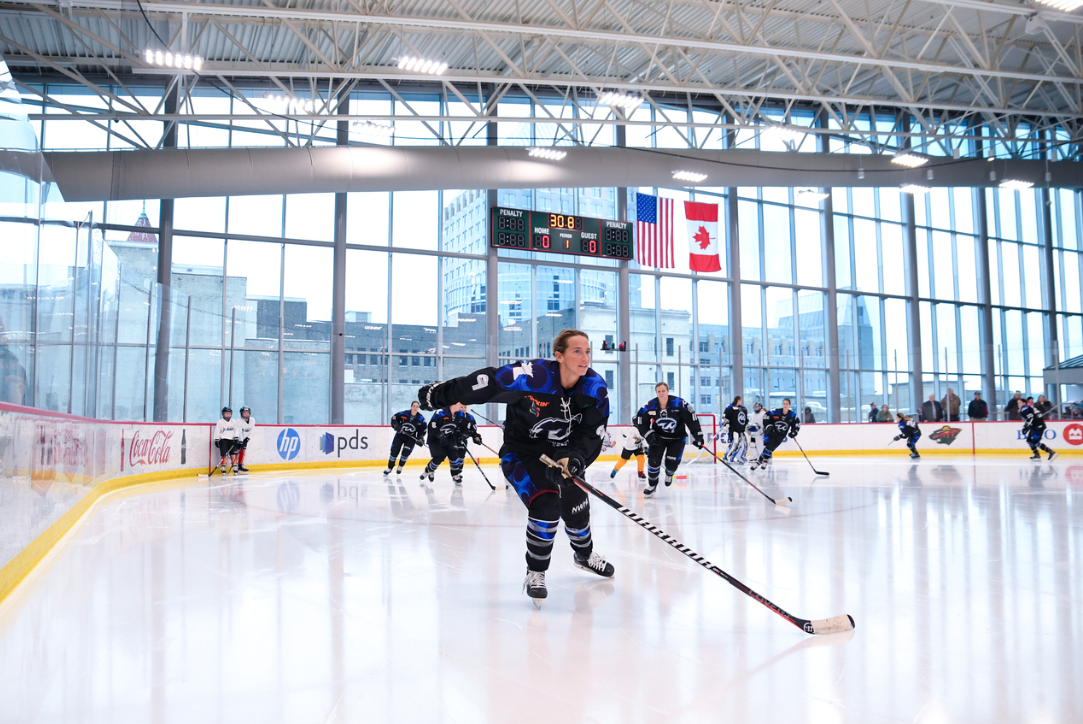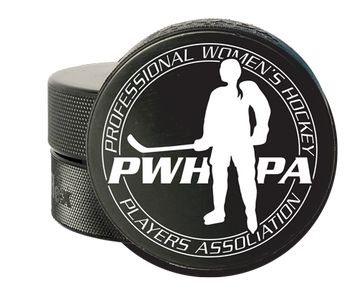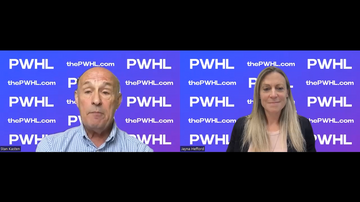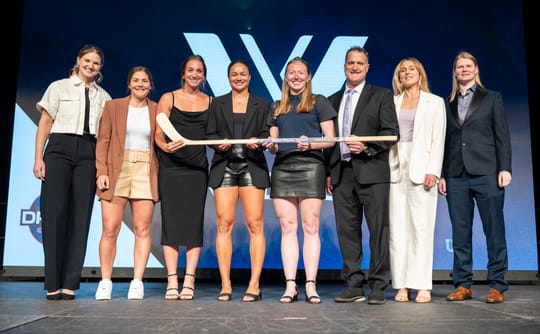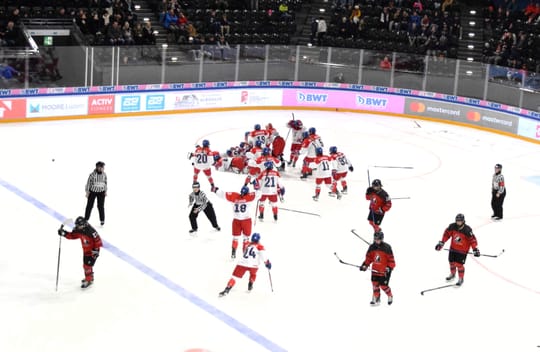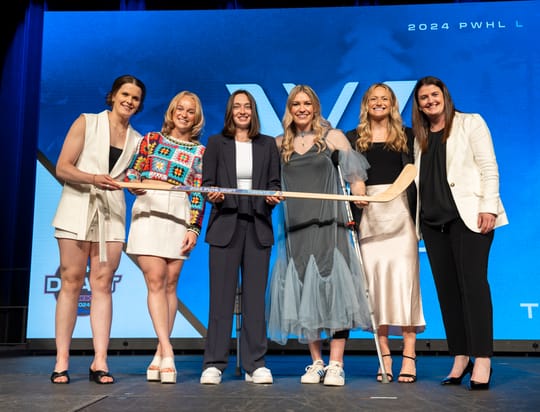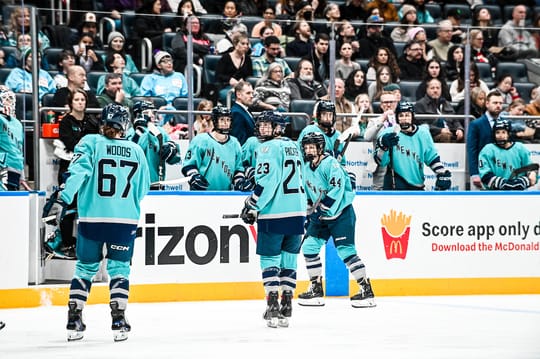Lots of people – players, fans, and media – were shocked when it was announced earlier this summer that the Premier Hockey Federation (PHF) had sold "assets" of the league to Mark and Kimbra Walter ahead of the launch of a new women's professional hockey league in January 2024.
In many ways, that shock was warranted. In recent months, the PHF signed over 120 players to contracts for the upcoming 2023-24 season. Those players then went on to buy houses, sign leases, and make other major life decisions. The PHF – which had been negotiating details of the sale for more than six months – celebrated the news as a victory for women's hockey, even as players struggled to comprehend the fallout from their voided contracts.
Members of the Professional Women's Hockey Players' Association (PWHPA) – who found out about the sale at the same time as PHF players – were also caught off guard by the news. The months ahead are uncertain, especially with the player pool set to shrink from 330-plus across the two groups to 138 in the new league.
So, yeah, the PHF sale was shocking and the timing was especially cruel. And yet, it is also something the women's hockey community should have seen coming from miles away – even if we didn't expect it to go down this way.
So why didn't we? Why was it so difficult to see through the noise?
The legacy of the rift
Let's start with the storyline everyone is well and truly tired of hearing about: the rift.
Rifts – and so-called rifts – in women's hockey did not start with the PWHPA and PHF. Last year, I wrote a story for NBC Sports on the long history of women's hockey leagues and documented how — for nearly as long as there have been post-grad leagues — people have questioned why two groups of leaders and players couldn't get along and play nice. Just ask players who competed in the original NWHL (1999-2007) and WWHL (2004-2011), or the CWHL (2007-2019) and second NWHL/PHF (2015-2023).
Whenever a new league started, it was the result of a disagreement or problem with the existing league. The WWHL was founded in 2004 after two Alberta-based teams withdrew from the original NWHL due to high travel costs. Then, when the original NWHL folded in 2007, the CWHL was founded months later as the stop-gap solution of the day. And Dani Rylan founded the new NWHL in 2015, but only after she was unable to bring a CWHL expansion franchise to New York. The NWHL would become the first professional league to provide players with salary, and would go on to be rebranded as the Premier Hockey Federation.
But the founding of the PWHPA was different because, at least initially, the players didn't step away to play in a new league. They stopped playing to force a disruption and demand better working conditions.
Tension, like it or not, was automatically woven into the situation. How could it not be? There was one league – and the best players in the world refused to play in it.
When players stepped away and founded the PWHPA in 2019, it seemed possible – perhaps even probable – that the NWHL would fold. But the league managed to stay afloat.
As years passed – and talent in the PHF flourished – fans and players, understandably, grew wary of the rift narrative. And so, when the PWHPA executive board unanimously voted in April 2022 to end discussions with the PHF, some in the women's hockey community adopted a new philosophy: two leagues are fine!
The most die-hard women's hockey fans, including the loudest voices that dominate the echo chamber that is Twitter, began championing this idea. While #OneLeague was the first goal, two leagues became an acceptable Plan B. Fans, sick of feeling forced to pick sides, would be able to watch more hockey. Two leagues would result in more roster spots! It would push ownership to raise the bar in order to attract the best players!
Plus, isn't that what capitalism is supposed to look like? Healthy competition and all that? If companies don't have to compete for business, what's to keep them from exploiting workers and consumers? In many ways, the promise of what two leagues would mean was illustrated by the PHF's continued efforts to court players to join the league by raising salaries.
But when it comes to women's hockey, was the idea of two leagues logical? Did it make sense given the market? Was it informed by what the WNBA and NWSL have taught us about how much money is required to operate a top tier sports league?
In the year 2023? Absolutely not. It didn't make sense in 2018 or 2019 either. Or in 2015 when the PHF first launched alongside the CWHL.
Thanks to the "nO-oNe-WaTcHeS-wOmEn'S-sPoRtS" crowd, women's sports fans are known to get in formation whenever called upon to defend the leagues, teams, and players they love most. And while this type of passion and advocacy is vital to the growth of women's sports, it can also keep fans from asking tough questions, including: is this thing I love actually making money? Is it actually doing what it purports to do, and most importantly, does it do it well?
The money problem
While dedicated fans may have been willing to give their attention and dollars to two leagues, was any investor – either on the side of the PHF or PWHPA – willing to spend Capital-D Dollars on a league facing competition?
In 2022, Johanna Boynton – then Principal Owner of the Toronto Six – spoke at the MIT Sloan Sports Analytics conference. In her presentation, she discussed why her investment in the league was a business decision, not charity, and provided a big picture vision of how the PHF would become profitable.
On a slide labeled "the formula for sustainability," there was a simple equation: sponsorship + broadcast + gate + merchandise = sustainability. On a following slide, she outlined four potential financial outcomes over the next three seasons, with all four scenarios resulting in teams breaking even ahead of season 10. "We are on track to break even in the next 2-3 years," the next slide read.
Within that is an unspoken reality: we are not currently breaking even, and breaking even is still, at best, a few years away.
Now, I haven't seen the PHF books. I don't know how much they were making – or not making – in any of those four categories. But there were plenty of signs that it wasn't nearly enough, from the small venues that limited gate revenue to the fact that the league – not ESPN+ – was responsible for the cost of producing game coverage for the streaming platform.
Now, it isn't automatically a problem if the PHF wasn't making money – most sports leagues fail to generate a profit in the early years, some even beyond that — but leagues can only continue so long as ownership is willing to eat those losses. And owners are typically only willing to do that so long as there is a clear path to profitability and sustainability in the future.
And if there are two leagues? That makes the path even tougher.
As much as the rift narrative frustrated players and fans, the divide was messy. It wasn't just the NHL that didn't want to take sides. Sponsors were confused. Broadcasters too.
Dani Rylan famously told The Athletic in 2019 that the "best four weeks of business" came between the CWHL folding and the PWHPA forming.
"And I think part of that was because we provided so much clarity to the market. There was one league for brands, players, investors, supporters and fans to commit to, so there was an influx of interest that presented itself after the CWHL folded," Rylan said.
That message was echoed by the PHF's new owners, too.
"Women's pro hockey is at a very fragile stage of development," PHF Board of Governors Chairman John Boynton told The Globe and Mail in 2022. "And if there are two separate leagues, we're dividing fans, dividing sponsors. It's confusing and I just think that the sport as a whole is not going to get the kind of support or be able to build the kind of momentum that would be possible if we were working together."
This is what the Mark Walter Group bought, and what the PHF willingly sold.
Yes, the deal includes "assets" of the PHF league and franchises, but that's not what the sale was about. The real value is the clarity that comes from knowing that — ahead of the first puck drops in January 2024 — sponsors won't be confused about what they're getting themselves into. There won't be any arguments about where the best players in the world are playing.
The new women's hockey league – name still to be announced – also isn't likely to make a profit anytime soon, but its path will be smoother. Eliminating the competition was indeed the goal, not because competition isn't fine and good, but because the market requires clarity in order to succeed beyond what the WWHL, CWHL, original NWHL, PHF, and PWHPA were able to do.
The PHF did not eliminate or convert the competition, and when they realized they weren't going to do that, they chose to sell rather than compete. Ownership gets to cut its losses now, rather than spending a year competing against a league that appears likely to have a stronger financial foundation, more marketing power, and unionized players. After all, this is a business, not a charity.
When I spoke to Stan Kasten after the sale, I figured I might as well ask if he'd be willing to divulge the price tag of the league. "Not even the tiniest chance," he said with a laugh.
We may never know the answer to this question due to the NDA, though PHF ownership has said that the sale will not result in a profit.
Unsuccessful attempts at courtship
While recent PHF improvements – and salary promises – certainly benefited players already in the league, PHF ownership and leadership made no effort to hide the fact that they were attempting to attract the best players in the world.
And, to some degree, it worked. A handful of top players (headlined by Daryl Watts, Kacey Bellamy, and former PWHPA board member Noora Räty) signed with PHF teams in the lead-up to what would have been the league's ninth season. In the last year, a huge influx of high profile European players also joined the league thanks to the salary increases – allowing them to move to North America just to play hockey in line with the restrictions associated with athlete visas.
But as time went by, some in the women's hockey community – including PHF leadership – clearly became frustrated that the PWHPA players were still barnstorming. A sentiment emerged that enough time had passed and enough improvements had been made that PWHPA players should stop complaining and just make nice, despite a documented history of issues with working conditions and player safety in recent years.
I spend more time than is healthy sifting through comments on articles and wading into Twitter threads. And one thing that always surprises me – especially given everything we have learned from women's soccer about safety and player rights – is that so few observers seemed to trust players to make their own decisions, while simultaneously placing a disproportionate amount of faith in flashy press releases.
Any article about the PWHPA's goals or plans would inevitably bring commenters asking, "wHy DoN't ThEy JuSt JoIn ThE pHf?"
And yet, any time a PWHPA athlete cited their reason for not joining the PHF, commenters would call them greedy or selfish – or argue they were "harming women's hockey" if they said anything remotely negative about the league.
Less than two weeks before the PHF voided all of its player contracts, Hilary Knight was called out by some women's hockey fans for referencing the "illusion of professionalism" in the league.
Is it true that the PHF/NWHL improved since Knight last played in the league in 2017? Absolutely. From higher salaries to the addition of health insurance benefits, the changes were immense – and commendable. But none of that meant Knight or her fellow PWHPA players were required to join the PHF or shouldn't have autonomy over their own careers. None of them were obligated to play in the PHF from a moral or ethical perspective. None of them were required to take less than what they believed they deserved to "save the sport" or to send the sport on any specific trajectory. And, likewise, none of them were required to stay put in the PWHPA – as we saw when some members opted to sign with the PHF.
But even as the PHF increased player salaries, the league's long-term business plan remained unclear and the players' association remained non-unionized and vulnerable. While the PHF was often cited as the "side" of the rift with the infrastructure, what did that infrastructure look like? Teams didn't own their own rinks (which were small and changed frequently); most staff members were part-time and worked other jobs to make ends meet; and, as anyone who covered the league can attest, there was always a struggle to get timely press releases, transparent communication, and accurate stats.
The PHF may have had bigger and better plans for the future, but any further investment in that future required one thing the league couldn't secure: the best players in the world. And they weren't going to bring them into the fold anytime soon.
We don't have to be doomed to repeat the past
I know lots of women's hockey fans doubted that the PWHPA was actually going to launch a new league. I've seen the tweets. The "I'll believe it when I see it" or "if they want a league, they should quit talking about it and do it" sentiments. Some of these same people were among the most shocked when the PWHPA confirmed that it had, in fact, been negotiating a real collective bargaining agreement (CBA) all these months.
But it is also worth noting that, even if the PWHPA hadn't been doing anything, even if players had been sitting at home on the couch instead of negotiating a CBA, even then, they still would be allowed to say, "I deserve better than what currently exists."
I realize some people will view this as a radical idea, but it is one informed by years of covering other women's sports and especially women's soccer.
The National Women's Soccer League (NWSL) was rocked by abuse scandals, which led to the resignation or dismissal of half the league's coaches and the league commissioner in 2021. In a report released the following year, former acting U.S. Attorney General Sally Q. Yates explained how a lack of basic workplace protections, insufficient staffing, and lacking infrastructure in the NWSL created an environment in which abuse could thrive.
"Multiple players reported that they were discouraged from raising concerns and repeatedly told to be 'grateful' that they had an opportunity to play professional soccer. Team and Federation leadership explicitly encouraged players to protect the League from failing as its predecessor leagues had. Some former players and veterans endorsed this message. As a result, players felt as though they had to tolerate unprofessional—and even unsafe—conditions," Yates wrote.
While there is no indication of similar abuse in women's hockey, the sport has long lacked adequate player protections and professional working conditions. And while the respective situations with hockey and soccer may not seem similar at first glance, there is a long history of women's hockey players learning from their soccer counterparts.
When I spoke to PWHPA Operations Consultant Jayna Hefford last fall, she cited both the Yates report and Hockey Canada scandal as reminders of why the PWHPA's work was so crucial.
"I read some of the comments from the soccer players that they just wanted to play, they just wanted to be in a league," Hefford told me. "And our players feel the same way and that's what's made this so challenging is that they just want to play. I get that. As a former player, I feel the same way. But I think we also have a lot of comfort in knowing that we are doing this the right way, we are doing the work that – in our minds – has never been done for women's professional hockey."
I've said it before and I'm sure I'll say it again: the more I've learned about the history of women's soccer, the more I've learned about the future of women's hockey. Many of the similarities can even be traced to the fact that the U.S. hockey team and PWHPA now work with the same legal firm (Ballard Spahr) that previously advised the U.S. women's soccer team in the 1990s and 2000s.
When the PWHPA was formed in 2019, it marked the latest chapter in the tussle between gratitude and demanding better for the next generation. PWHPA players stepped away from the game, just as the U.S. women's hockey team did ahead of the 2017 World Championship, and members of the U.S. national soccer team did in 2000. And just like Billie Jean King and the Original 9 did in 1970.
"At its core, it's about the same goal, and that is about supporting a group of women who are passionate about their sport, are dedicated to their sport, who are willing to sacrifice their own careers and their own opportunity to play by looking at the longer-term goals, looking at the bigger picture, and looking at the opportunity to really raise the profile of their sport and to grow the sport for future generations," Ballard Spahr attorney Dee Spagnuolo told the Victory Press in 2019 following the formation of the PWHPA.
There is a concept often cited in the energy and technology industries called "leapfrogging." In simple terms, it is the idea that developing countries don't need to industrialize by using coal, oil and gas when the technology for renewable energy already exists. Or that remote and disconnected villages don't need to build out infrastructure for landline phones when they can just build cell towers.
While "leapfrogging" is rarely cited in sports, it is a concept I found myself thinking about when I spoke to PWHPA members and leadership in recent years. Because while it may have taken the WNBA three years to sign a CBA – and nine years for the NWSL – that didn't mean women's hockey had to follow the same model.
Looking through the collective bargaining agreement that the Professional Women's Hockey League Players' Association (the union formed by PWHPA) negotiated, it is easy to see what the PWHPA had been saying for years: it was never just about the salaries. The 62-page agreement encompasses a series of lessons learned from previous women's hockey leagues – and from other sports, too.
The CBA outlines details on concussion protocol enforcement. Medical staffing. Guaranteed competition bonuses that are paid out in cash, not gift cards. A $1500/month housing stipend for each player. Meals provided before and after every training session and game. Relocation expenses. Parameters around how many hours players are expected to work each day. A health insurance plan with no premium or deductible.
That doesn't mean the CBA is perfect or that players didn't compromise (they did), or that we should implicitly trust the new ownership group (we shouldn't – that's why the PWHLPA negotiated a legally binding document with them to establish certain standards). But the CBA does assure that the future of women's hockey will look very different from its past. The players, for the first time in women's hockey history, have a seat at the table that is backed up by more than just promises and press releases.
The illusion of inherent fragility
Throughout the history of women's sports, players have been told that their league was at risk of collapse if they didn't take a pay cut or if they unionized or if they spoke up about issues with facilities and conditions. But that didn't happen here, far from it.
In retrospect, with a 32,000-foot view, what surprises me the most about this most recent chapter of women's hockey history is that the NWHL didn't collapse after more than 200 active players pledged to not play for them in 2019.
Instead, the league plugged along – and then improved. New ownership stepped in and changed the structure of the league. Salaries were raised, the league expanded, there was a leadership overhaul, and some PWHPA players – understandably – saw the improvements and returned.
The PHF wouldn't have improved at such a drastic pace if not for the players who stepped away in 2019 and stayed away in 2020, 2021, 2022, and 2023. It also wouldn't have shuttered – at least not in the year 2023 – if all of those players had come back.
And so, while we likely should have seen the PHF sale coming, it is also worth remembering that what the PWHPA ultimately built was never foretold. When players stopped playing in 2019, they didn't realize it would take more than four years to see their vision through. I know some believed that the NWHL would fold and the NHL would step in. But when that didn't happen, they hired consultants and made their own sales pitch.
In the wake of the PHF sale, some have claimed – including a now-former PHF owner – that the only thing PWHPA players wanted was control, as if wanting control is inherently bad.
But control, for a worker, is a very powerful thing, and the PWHPA athletes are workers who had a choice: a choice to leverage their power to demand something better, or to give in to something they didn't think was right. While the PHF sale is the natural conclusion of PWHPA players refusing to play in the league, it also sends a message long ignored in women's sports history: players have power.
(Photo: Premier Hockey Federation/Tom Morris)
